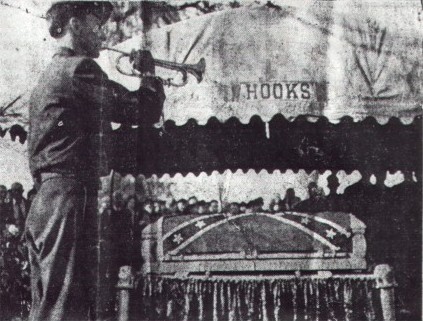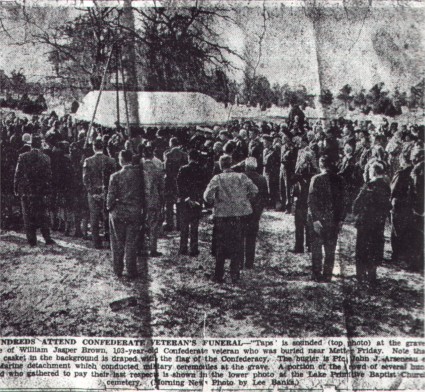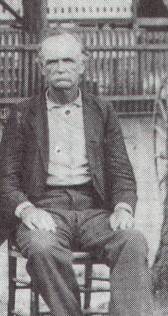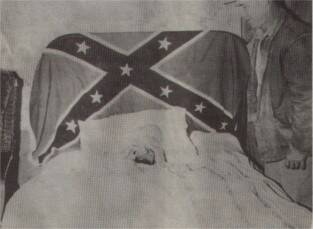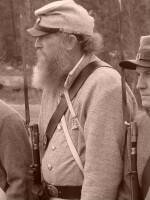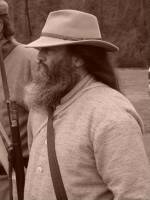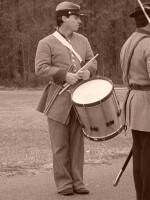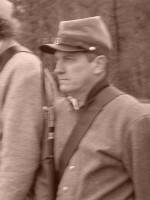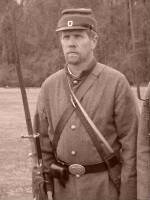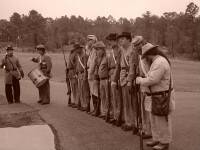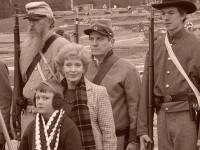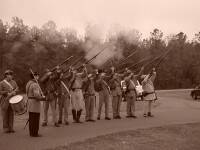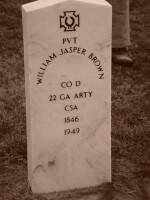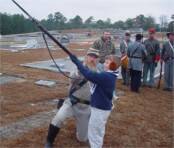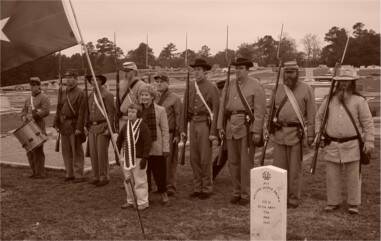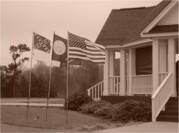The story of William Jasper Brown was told in a book written by University of Maine professor Jay S. Hoar called "The South's Last Boys in Gray". Click here to buy the book.
Click here for more details on the service records of Pvt. William Jasper Brown compiled by our camp historian.
According to an editor’s note published in the Metter Advertiser in the later part of 1992 by Mrs. Virginia Snell, Professor Jay S. Hoar (U. of Maine at Farmington) wrote to the Advertiser via a letter to the editor in January of 1992. In his letter, he requested a picture and any additional info the people of Metter might have regarding soldier Brown. Hoar had previously visited Metter in 1972 to research Brown’s story for his book, The South’s Last Boys in Gray (published in 1986). Snell’s note indicated that the following article, which appeared in the Advertiser, also ran in the Confederate Veteran magazine in 1992. Excerpts of this article were also featured in a compilation on Brown by Ogeechee Rifles historian Smith Callaway Banks that appeared in the 1996 Bulloch County history book called “Spirit of a People”.
Jasper Brown was among Georgia’s final Gray triumvirate, a farmer most of his adult life.
He was the younger son of Joseph M(anning) Brown, whose dwelling place was between Aaron Station and Garfield. There he grew up to become a tall, tough, blue-eyed lad. While Jasper helped keep the farm going, his brother Jim went to the War Between the States first.
Though details of his own war record are elusive, [See above: 22nd Ga. Artillery] Brown was a full 18 when he served eight months with a Georgia infantry unit during 1864-65. Lewis Boatright, an octogenarian living near Garfield In the 1970s, shared these Jan. 21. 1974, thoughts of his old friend.
“Mr. Brown lived on his small farm near my home during 1880-1918, and my folks and me were neighbors nigh on 50 years all told. He grew cotton, corn, hogs cows and vegetables for his own use mainly. His wife died about 1897. He liked to be of service to his friends had a beautiful gray horse and a buggy he enjoyed. He’d talk on his Confederate Army experiences some. In spare time he’d fish in the creek by his farm. Poor Mr. Brown lost his farm to his doctor friend when he was not able to pay his bills.”
“I remember him as an independent. honest, upright gentleman whose desire was for a better state and nation for future young folks to enjoy. Good old Jasper hoped for a life after death where there would be no wars, tears, sorrows nor trials.”
Mrs. Leroy (Sue Nell) Stapleton, who was 69 in 1992, lived in Metter.
On March 7, 1973, she recalled:
“Our friend, William J. Brown, joined Lake Primitive Baptist Church (2 miles east of Metter) in June 1936 during their big meeting and was baptized in the heated church pool. He was too old to be baptized in 15-Mile Creek that runs behind Lake Church. He was honored by citizens of Bulloch County on Memorial Day (April 27th) 1937, in Statesboro when he was 91; he was then noted as the sole remaining Confederate Veteran in our county and he held that distinction for 12 years.”
“His wife was Matilda Williams and they had a daughter, Nan, I believe, who died in the late 1930s. After losing his own place, he moved into the little home of the J M. Rooks, Rt. 2, Summit. Mrs. Rooks’ father — Matthew — was brother to William Jasper. Her Uncle Jasper was quite a character He prevailed upon the Rooks to move an old car (that wouldn’t run) to a favorite spot of his. Lazy afternoons he’d go out to sit in it and bask by the hour managing, at times, a trifle of liquid refreshment for his quiet ride in the sun.”
More memories
Finally (and modestly) in her April 26, 1973, response Pheriba (Mrs. John Marshall) Rooks (March 24,1893 - Oct. 24,1979) of Metter offered:
“I knew Uncle Jasper about 35 years. I guess. Being tenant farmers on a sandy knoll, our dwelling was hardly a rest home worthy of one of Dixie’s old heroes. I kept him 13 years, the last four of which he was about helpless and bedfast. His low-ceiling room was unheated and a kerosene lamp was our only lighting at Summit, Georgia. in those days.”
“I wish we could have done better by him, but we didn’t have the means. I cooked soups and fed him by spoon. Like my husband J. M., said at the time, ‘We are proud we did all our means let us, but now we just don’t have what It takes to put him away the way he deserves. We’ve appealed to the welfare so he won’t go to a pauper’s grave, but no one has told us he’ll get a decent funeral’.”
Mrs. Rooks, easily the equal of a practical nurse, kept her home and her patient’s bedding spotless. By late January 1949 the plight of the Rooks was discovered when MS. Durden of nearby Graymont wrote to a newspaper:
“Could some person lend Mr. Brown a comfortable wheelchair, for his last days certainly aren’t many.” Oglethorpe Sanitarium quickly donated the chair via a group of U.S. Marines.
Though Pheriba (“Aunt Miss”) as she was sometimes known was in a hospital from overwork, the arriving Marines were given a warm welcome by Mr. Rooks.
As he led them to Browns bedside, sunlight pierced into the little antechamber between wide boards. The Confederate flag covering Uncle Jasper’s headboard had its own story. The Rev. F.H. Sills, Candler County legislator and civic groups had responded in 1941 when they learned of the old soldier's request for it. Sills would remember the day he presented the flag.
“There were big tears in his eyes when I gave it to him. He was blind then, but he rubbed his hands over the folds and said, ‘I marched many a mile under this flag’.
And now, eight years later, the old warrior lay beneath Dixie’s colors, too weak to lift his head. As the Marines brought in the wheelchair, he was blinking and whispering ‘Tell them I thank them.’” (See photo below)
“While they stood by his bedside, a Marine asked Brown if they could do something for him. Hoarsely he spoke, ‘Give me a drink!”’ — whereupon, Mr. Rooks noted that Brown didn’t mean water. Swiftly the Marines reconnoitered a store, captured two bottles of wine and retreated to their new-found comrades bedside.”
“This being his 103rd birthday. Old Reb Brown, all gratitude, took several sips as J.M. held a bottle. With surprising strength he raised from his pillow enough to render his company a smiling salute. When these Savannah members of Company D Infantry Battalion, Marine Corps Reserve, learned that Brown would be carried to a pauper’s grave, they promised that this would never be. They organized fund-raising in Savannah. One Marine, insisting he remain unknown, donated a $500 casket.”
William Jasper Brown clung to life those last four days beyond his 103rd, just long enough for the funds to. be raised. Some 500 Georgians came to his funeral; among them were nine members of Francis S. Bartow Camp 93, S. C. V.
The Savannah Marine detachment gave its comrade full military graveside honors at Lake Primitive Baptist Church Cemetery. It was noted he had been “among loved ones where he had wished to be!’ After all expenses were paid, poetic justice won out when Pheriba Rooks was presented the surplus, a token of appreciation for her excellent care of the old veteran during his invalidism.
The information on this page was compiled from
material donated by Mrs. Pam Griner, 2nd great riece of
Pvt. Brown, her husband Bob Griner-Dixie Guards SCV
member, Smith C. Banks-historian for the Ogeechee
Rifles SCV Camp of Bulloch County and Richard
Crotwell-Dixie Guards SCV Camp historian.
Photo at right shows J.M. Rooks standing with Jasper Brown
during his final days, with the flag he requested atop his bed...
On 14 Dec 2003 The Dixie Guards, Sons of Confederate
Veterans held a marker dedication for the newly installed
headstone at Pvt. Brown's burial site. His grave had
previously been marked with a Southern Cross of Honor.
Pictures and video of that ceremony are posted below.
Reenactors from several area camps came to make this a memorable occasion for a memorable veteran. Special thanks go to the honor guard which included members of the Ebenezer Rifles of Effingham, Ogeechee Rifles of Bulloch, and John C. Carter Camp of Waynesboro.
